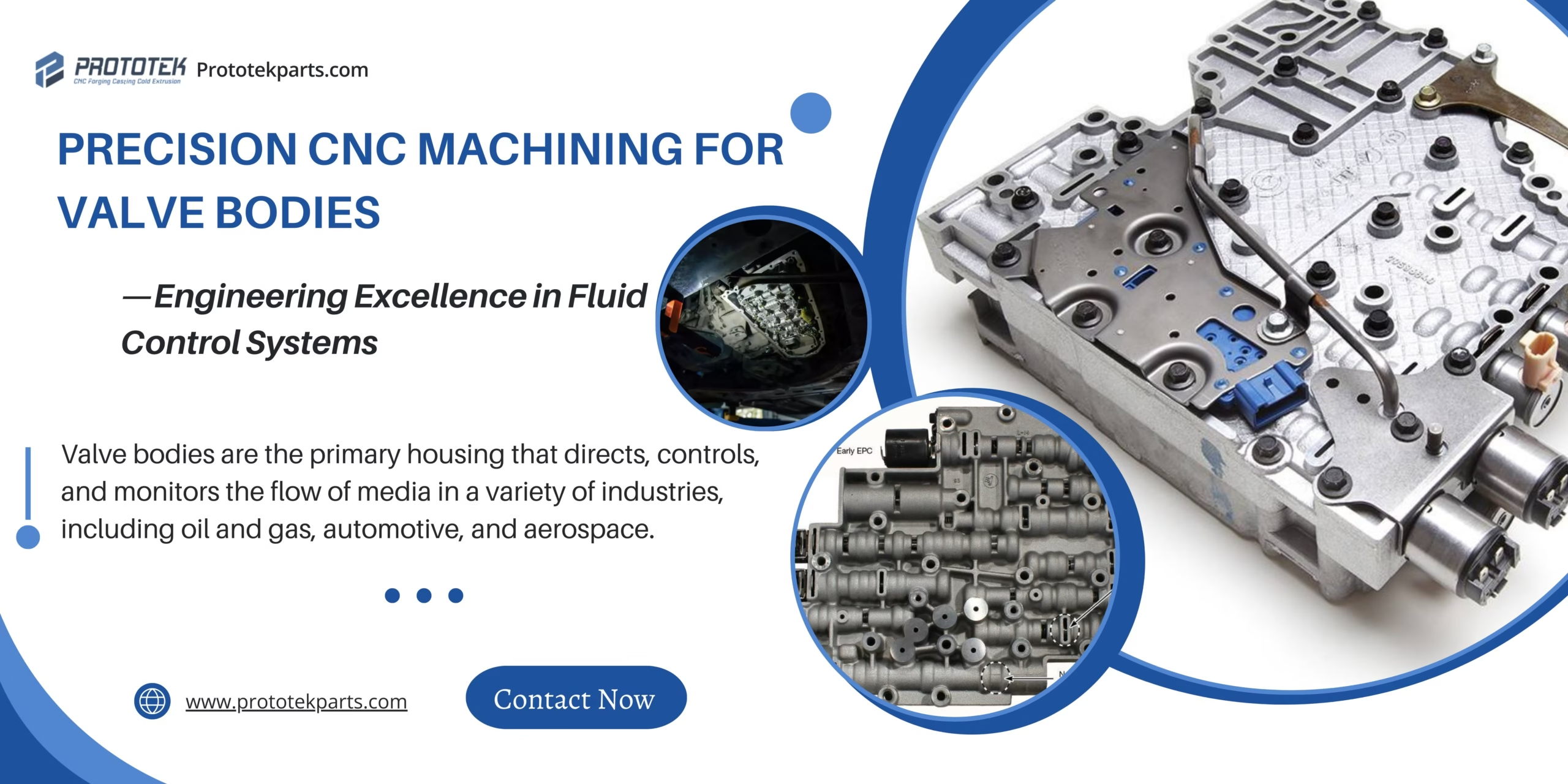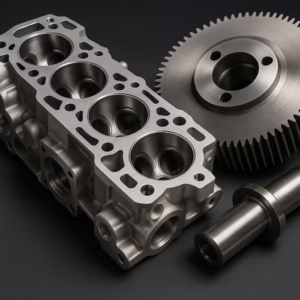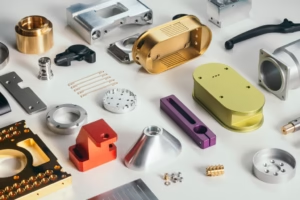Precision CNC Machining for Valve Bodies
Valve bodies are the primary housing that directs, controls, and monitors the flow of media in a variety of industries, including oil and gas, automotive, and aerospace. They are also an important part of fluid and gas control systems. Manufacturing accuracy is critical because the performance of the valve is determined by the accuracy, robustness, and reliability of the valve body. Computer numerical control (CNC) machining is the industry standard for manufacturing quality valve bodies, combining cutting-edge technology with careful engineering design. This article will take a deep look at the role of CNC machining in valve body manufacturing, important design factors, and how Prototek’s experience ensures the quality of valve body production.
The Importance of Valve Bodies in Fluid Systems
A valve body acts as the structural core of a valve, housing internal components such as the stem, seat, and disc. Its design dictates the valve’s functionality—whether it’s a ball valve, gate valve, or check valve. Key requirements for valve bodies include:
- Leak-proof performance: To prevent media leakage under high pressure.
- Corrosion resistance: To withstand aggressive fluids, gases, or environmental conditions.
- Dimensional accuracy: To ensure proper alignment of internal components and smooth operation.
- Structural integrity: To endure mechanical stress, temperature fluctuations, and cyclic loading.
Given these demands, CNC machining is indispensable for achieving the tight tolerances and complex geometries required for modern valve systems.
CNC Machining: The Ideal Solution for Valve Body Production
CNC machining offers unmatched precision and repeatability, making it the preferred method for manufacturing valve bodies. Here’s how CNC technology addresses the challenges of valve production:
1. Complex Geometry and Internal Features
Valve bodies often feature intricate internal channels, threaded ports, and sealing surfaces. Multi-axis CNC machines (e.g., 5-axis mills) can produce these geometries in a single setup, reducing errors and ensuring consistency.
2. Material Versatility
Valve bodies are manufactured from materials such as:
- Stainless steel (e.g., 316L, 17-4PH): For corrosion resistance in chemical and marine applications.
- Carbon steel: For high-strength, high-pressure environments.
- Brass and bronze: For low-pressure plumbing and HVAC systems.
- Exotic alloys (e.g., Inconel, Hastelloy): For extreme temperatures and corrosive media.
CNC machines handle these materials efficiently, adapting tool paths and cutting parameters to optimize surface finish and tool life.
3. Tight Tolerances
Valve bodies require tolerances as tight as ±0.001 inches (±0.025 mm) to ensure proper sealing and component alignment. CNC machining achieves this precision consistently, even for high-volume production runs.
4. Surface Finish Requirements
Smooth internal surfaces are critical to prevent turbulence, erosion, or contamination. CNC processes like grinding, honing, and polishing can achieve surface finishes as low as 0.2 µm Ra.
Key Challenges in Valve Body Machining
Despite CNC machining’s advantages, producing valve bodies involves several challenges:
- Internal Cavity Accessibility: Deep bores and narrow channels require specialized tooling, such as extended-reach end mills or boring bars.
- Thread Integrity: Precision threading for ports and fittings demands advanced tapping techniques and thread milling.
- Heat Management: Machining hard materials like stainless steel generates heat, necessitating coolant strategies to prevent warping.
- Quality Control: Post-machining inspections, including checks of coordinate measuring machines (CMM) and pressure testing, are essential to validate performance.
Prototek: Elevating Valve Body Manufacturing Through Expertise
At Prototek, we specialize in delivering precision-machined valve bodies that meet the stringent demands of industries worldwide. Our commitment to excellence is reflected in every stage of production:
a. Advanced CNC Capabilities
Our state-of-the-art CNC facilities include 5-axis machining centers and Swiss-style lathes, enabling us to produce complex valve bodies with unparalleled accuracy. Whether prototyping or scaling to high volumes, we ensure consistent quality across all orders.
b. Material Mastery
With decades of experience, our team selects and machines materials optimized for your application. From corrosion-resistant stainless steels to high-temperature superalloys, we tailor solutions to enhance valve performance and longevity.
c. Precision Finishing
Prototek’s secondary services, including passivation, plating, and laser marking, ensure valve bodies meet aesthetic and functional requirements. Our surface treatments enhance corrosion resistance and wear properties, extending component life.
d. Rigorous Quality Assurance
Every valve body undergoes rigorous inspection using advanced metrology tools, including CMMs and optical comparators. We adhere to ISO 9001 standards and customer-specific certifications, guaranteeing compliance with industry regulations.
e. Collaborative Engineering Support
Our engineering team partners with clients to optimize designs for manufacturability (DFM). By refining tolerances, material choices, and machining strategies, we reduce costs and lead times without compromising performance.
Applications of CNC-Machined Valve Bodies
Prototek’s valve bodies are trusted in critical applications such as:
- Automotive: Fuel systems, turbochargers, and transmission controls.
- Aerospace: Hydraulic systems and cryogenic fluid management.
- Oil & Gas: Wellhead controls, pipeline valves, and refinery equipment.
- Medical: Gas delivery systems and sterilization devices.
Conclusion: Trust Prototek for Precision Valve Body Solutions
In an era where fluid control systems demand ever-greater precision and reliability, the choice of manufacturing partner is crucial. Prototek stands at the forefront of CNC machining innovation, combining cutting-edge technology, material expertise, and uncompromising quality control to produce valve bodies that excel in the most demanding environments.
- By partnering with Prototek, you gain access to:
- Rapid prototyping to accelerate product development.
- Scalable production with seamless transitions from prototype to volume runs.
- Industry-specific expertise to meet regulatory and performance standards.
For valve bodies that embody precision, durability, and engineering excellence, trust Prototek to deliver solutions that keep your systems flowing flawlessly.
If you have any needs, contact us via email at Lynnyao@prototekparts.com 或致电+86-0792-86372550
标签
- 自动螺旋机产品

























































